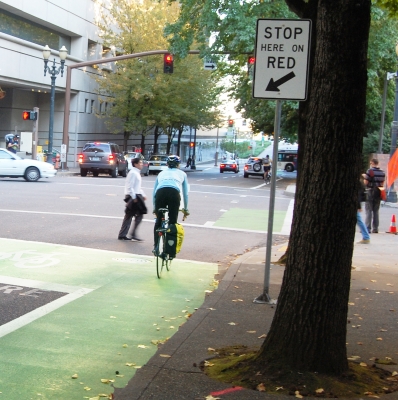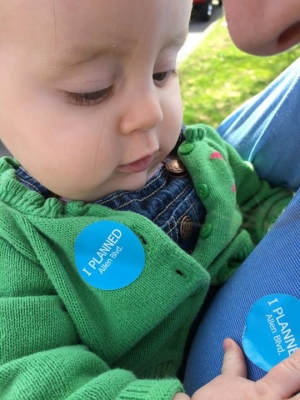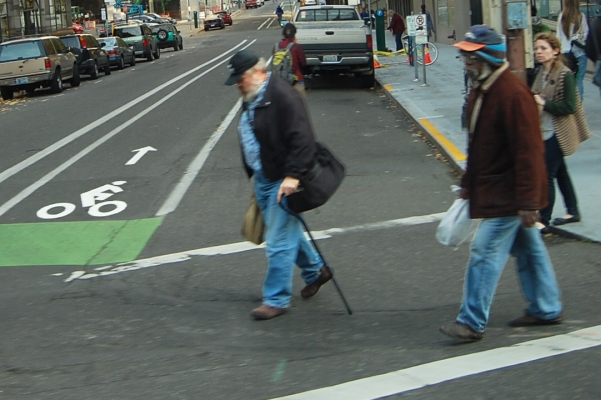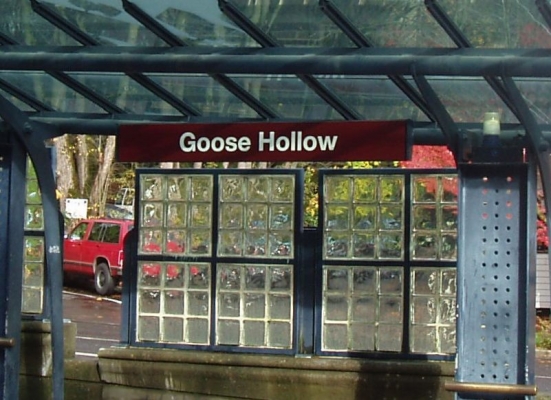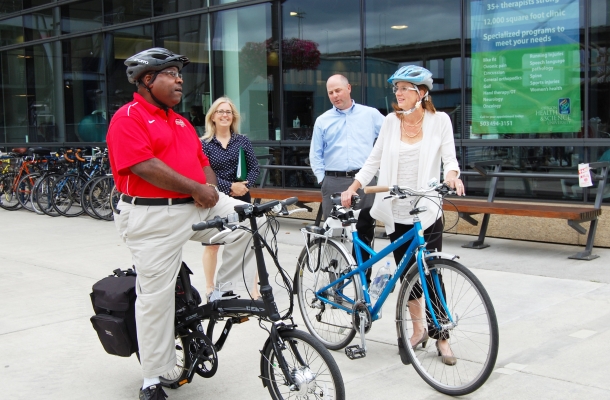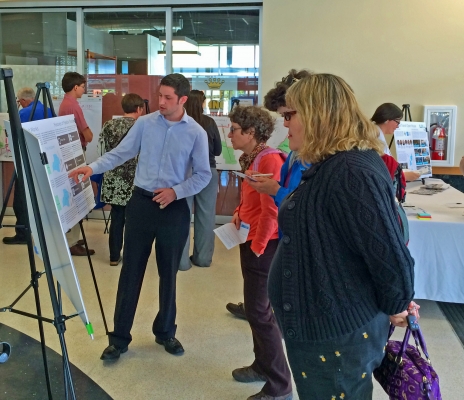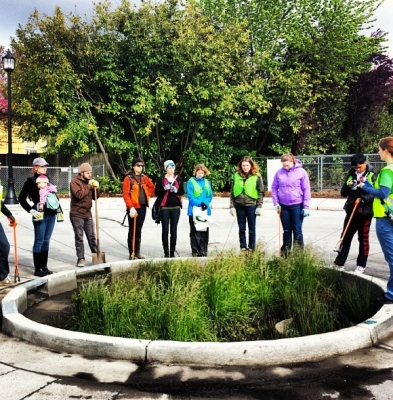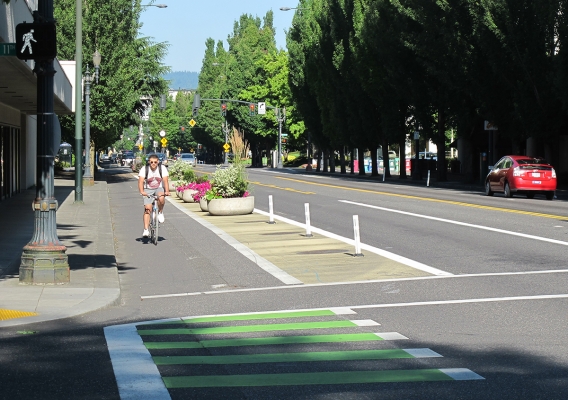Several notable transportation projects have come out of Portland State University’s Master of Urban and Regional Planning (MURP) program this spring.
Each year, graduating students finish up their two-year program of study by forming into groups and carrying out a professional project. Clients work with Portland State University to identify planning needs that would be a good fit for the MURP program, and students choose projects based on their interests.
...
Read moreOTREC researchers Krista Nordback and Sirisha Kothuri will present research at the North American Travel Monitoring Exposition and Conference (NATMEC) from June 29 to July 2, 2014.
The conference, organized by the Transportation Research Board, provides an opportunity for traffic monitoring professionals to share information about collecting and using traffic data.
Nordback will talk about what professionals can do to maintain bicycle count programs at the state level. She will give a presentation on the feasibility of using existing traffic signals to collect bicycle counts, and on what to do with that data once it is gathered.
Kothuri will present strategies for counting pedestrians using existing resources such as signal controllers and software already installed at intersections.
Nordback and Kothuri will draw from their own research as well as from the work of Miguel Figliozzi, Chris Monsere, ...
Read morePortland State University’s Master of Urban and Regional Planning (MURP) program matches students with clients every year to execute professional-level planning projects.
This spring, InSite Planning Group, a team of six MURP students, conducted a detailed corridor study for the city of Beaverton.
The ...
Read moreWhen it comes to transportation investments, states have a good measure of automobile traffic to inform decisions: vehicle miles traveled. Bicycling and walking don't have a similar measure, leaving more guesswork in planning for those modes.
OTREC research associate Krista Nordback is helping to fix that disparity for Washington state. Working with graduate assistant Michael Sellinger, Nordback has published a research report presenting methods to estimate cycling and walking in the state.
The research is part of a larger effort, which includes Nordback's NITC research project, to create and apply pedestrian-miles-traveled and bicycle-miles-traveled -- PMT and BMT, resepectively -- measures at the state level. In the report, Nordback recommends improvements to Washington's Bicycle and Pedestrian Documentation Project and outlines how PMT and BMT could be estimated.
Washington already leads the nation in its nonmotorized count program, collecting bike and pedestrian counts in more than 30 cities across the state. The statewide focus of Nordback's project sets it apart from similar studies limited to the local or regional level.
The report identifies key needs for programs such as Washington's, including more counts in rural areas and the need to combine short-duration counts with permanent counters. It also found that...
Read moreA group led by Krista Hager worked on a concept design for bicycle parking at the Goose Hollow eastbound MAX Station in southwest Portland, Ore.
Bicycle and pedestrian safety has emerged as a top priority for U.S. Transportation Secretary Anthony Foxx and the Department of Transportation. With this in mind, the department’s top research official visited Portland State University, home to the U.S. DOT-designated national center for livable communities.
Greg Winfree, the assistant secretary for research and technology, visited Portland State’s transportation research and education center June 13. Center Director Jennifer Dill and researcher Christopher Monsere gave Winfree a tour of the center’s living laboratory: Portland’s active transportation infrastructure.
Winfree, an advocate for improving safety for vulnerable road users, explored the city’s various bicycle safety efforts, including bike boulevards, protected bike lanes, bike boxes, bike-specific signals and signage. He also learned of pedestrian research involving traffic signals, crossings and...
Read morePortland State University students in the Master of Urban and Regional Planning (MURP) program came up with some innovative transit solutions for the Salem-Keizer area, just south of Portland, Ore. in the Willamette Valley.
The Salem-Keizer transit provider, known as Cherriots, requested that a planning group come up with alternative forms of transit that would be a better fit for the study area. MURP students Darwin Moosavi, Brenda Martin, CJ Doxsee, Mike Sellinger, Lauren Wirtis and Matt Berggren took on the challenge as their capstone project.
The bus service currently provided by Salem-Keizer Transit is inefficient in the low-density neighborhoods of West Salem, South Salem, and Keizer. Buses in those neighborhoods often run half-full, or nearly empty, along looping, circuitous roads that lack an interconnected grid pattern.
The student team, Paradigm Planning, proposed a “flexible transit” system which can better serve this type of low-density suburban area.
Fixed-route transit is typical bus service, in which buses come to predefined stops at regularly scheduled intervals. Demand-responsive or paratransit, the opposite extreme, is an on-demand service typically reserved for the elderly or disabled, in which a rider calls to be picked up by a bus at home....
Historically, large-scale transportation infrastructure projects have had devastating outcomes in communities of color. With twentieth-century urban renewal efforts often came the displacement of underprivileged communities, the loss of low-income neighborhoods and their replacement with affluent housing and freeways.
According to new OTREC research from the University of Oregon, transit-oriented development, or TOD, can offer a different trajectory. Rather than displacing residents, TOD has the potential to improve neighborhoods for the benefit of those who live there.
OTREC researcher Gerardo Sandoval grew up near MacArthur park, one of the two sites studied, and has witnessed firsthand the neighborhood’s dramatic change. “I think the coolest thing about MacArthur Park is that now it’s considered a national model for TOD. When I was growing up there … nobody saw it like that. It was thought of more as a low-income area,” Sandoval said.
The project examined two California neighborhoods: MacArthur Park, in Los Angeles, and Fruitvale, in Oakland. In both neighborhoods, the majority of residents are recent immigrants from Mexico and Central America, many of whom have significantly lower incomes and rely heavily on public transportation.
In the last few decades, both sites have seen TOD coincide with neighborhood...
Read moreA research study released Monday by the National Institute for Transportation and Communities program offers the most comprehensive evaluation of protected bicycle lanes to date. The study, “Lessons from the Green Lanes: Evaluating Protected Bike Lanes in the U.S.,” examines recently installed protected bike lanes in five of the six founding PeopleForBikes Green Lane Project cities and provides the scientific basis for decisions that could improve bicycling in cities across the United States.
Protected bike lanes, sometimes called cycle tracks, are on-street lanes separated from traffic by curbs, planters, parked cars or posts to help organize the street and make riding a bike appealing for people of all ages and abilities. Because protected bike lanes are relatively new to the U.S., little academic research has existed to help leaders evaluate the risks and rewards of the investment in putting the facilities on the ground.
This study provides definitive evidence that people feel safe riding in protected lanes and that people traveling by car or foot also support building more protected lanes to separate bicycles and automobiles. It also provides insight on the safety, use and economic effect of protected lanes.
THE METHODOLOGY: FIVE CITIES
Researchers visited each of the five...
Read more
